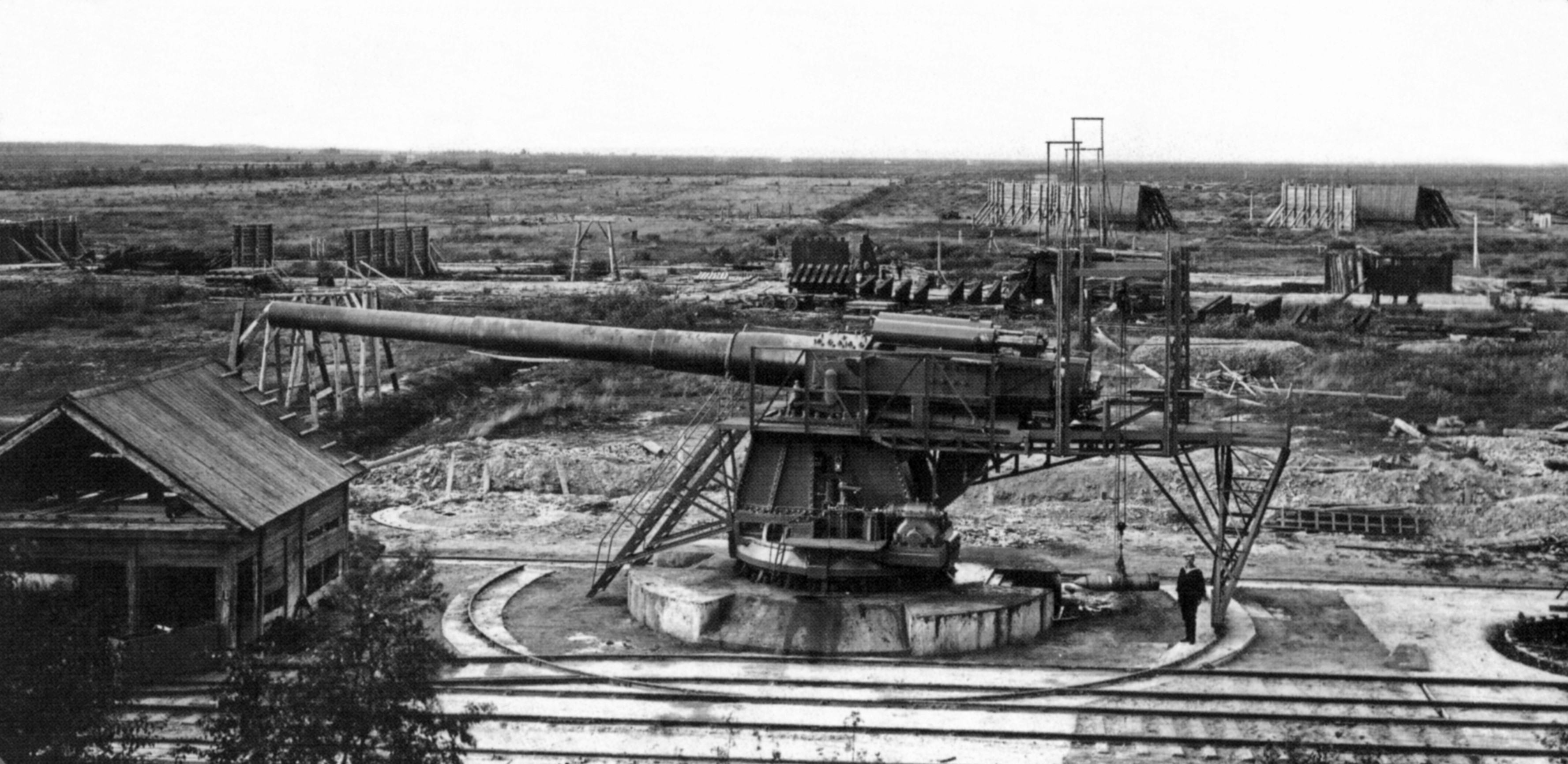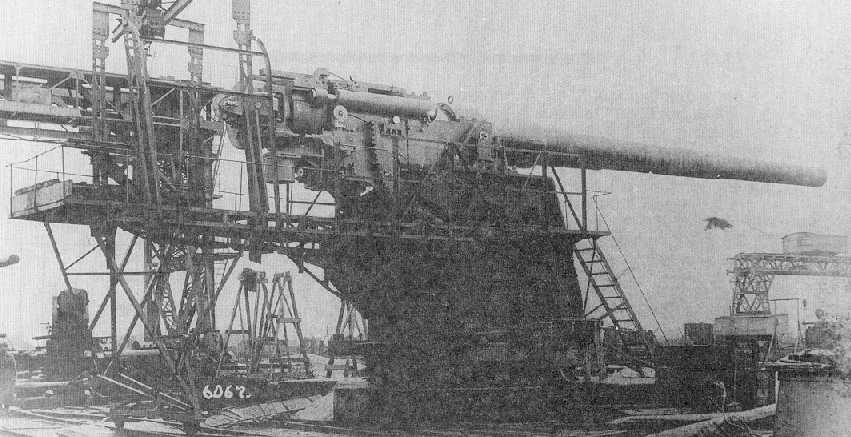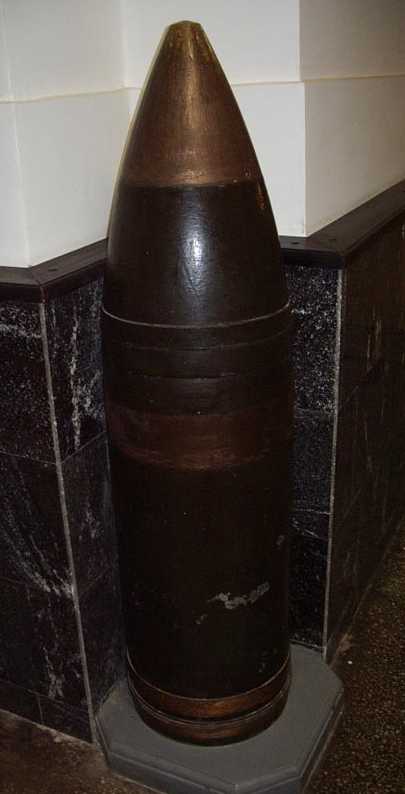This gun design was started in 1910 for arming the Imperatritsa Maria class battleships, which were to be built in the Black Sea shipyards. Orders were given to the Obukhovski Steel Plant (OSZ) and to the British firm of Vickers, but OSZ was unable to produce enough guns to meet the projected 1915 completion date of the battleships. In order not to become completely dependent upon foreign production, it was decided to arm these battleships with the older 12"/52 (30.5 cm) Pattern 1907 gun and to then use the 14" (35.6 cm) guns for the battlecruisers of the Izmail class, as they were to complete at a later date.
A total of 82 guns were planned, including four prototypes. Sixty of these guns, including twelve spares, were for the Izmail class and the last 18 were to be used in coastal defense batteries. Actual orders were placed for only 76 of these guns, with 36 going to Vickers and the remainder going to OSZ in St. Petersburg. Vickers designated these guns as the 14-in Mark B and production started in November 1913. Sixteen guns were completed by May 1917 with ten of these being delivered to Russia. Only one of the OSZ guns was ever completed.
The coastal defense guns were to be used in twin turrets and plans were made to build a total of eight turrets for three batteries, all sited near the entrance to the Gulf of Finland. Construction on these coastal batteries was started and the foundations were laid, but the turrets were not ready by 1917 and the project was abandoned.
Three of the undelivered Vickers guns were taken over by the British after the start of the Russian Revolution and then designated as the 14-in Mark VI. These were intended to be used on railway mountings, but they never saw service in France. This may have been because testing showed that they lacked strength, with seven of the sixteen guns proved showing signs of unacceptable expansion. The British also considered that these guns lacked longitudinal strength.
In 1925 there were eight Vickers barrels in Russian storage and ten (one source says seven) incomplete OSZ guns. Several times during the 1920s and 1930s the Soviet Union made plans to install these guns in coastal defense emplacements and even to construct a sea going monitor using the left-over turrets, but nothing was actually built.
During World War II, six of these weapons were used as Railway Guns TM-1-14 and were concentrated into two batteries. The first was used in Estonia for the defense of Leningrad while the second was used in the Far East and did not see any action. Another gun was used for tests with an an elevation of +60 degrees. During the war this last gun was used to fire at the Germans around the Leningrad area.
Nomenclature notes: As explained in Definitions and Information about Naval Guns, the British and Russians had differing ways of denoting the barrel length, hence the different designations shown above. The Soviet Union redesignated guns in metric units after 1917.
Constructed of built-up construction of A tube, four B tubes to the muzzle, three C tubes, two D tubes and jacket, a short breech ring and breech bush with a shrunk on collar screwed into the jacket. Used a Welin breech with Vickers mechanism.
| Designation | Russia
14"/52 (35.6 cm) Pattern 1913 356 mm/52 (14") Pattern 1913 Britain
|
|---|---|
| Ship Class Used On | Izmail Class (planned), twin coast defense turrets (planned), TM-1-14 railway mounts |
| Date Of Design | 1913 |
| Date In Service | 1931 (as railway guns) |
| Gun Weight | 82 tons (83.325 mt) |
| Gun Length oa | 728 in (18.491 m) |
| Bore Length | 705.8 in (17.927 m) |
| Rifling Length | 588.8 in (14.954 m) |
| Number Of Grooves | (84) 0.105 in deep x 0.36 in (2.67 mm x 9.14 mm) |
| Lands | 0.16 in (4.06 mm) |
| Twist | Uniform RH 1 in 29.89 |
| Chamber Volume | 21,940 in3 (360 dm3) |
| Rate Of Fire | Triple ship turrets: 3 rounds per minute at -5 / +15 degrees
Twin Coastal Defense turrets: 2 rounds per minute Railway Guns: 1.5 rounds per minute |
| Type | Bag |
|---|---|
| Projectile Types and Weights 1 | Britain
APC Mark Ia (?) - 1,586 lbs. (719.4 kg) Soviet Union
|
| Bursting Charge | Britain
APC Mark Ia (?) - 61.4 lbs. (27.9 kg) Soviet Union
|
| Projectile Length | Britain
N/A Soviet Union
|
| Propellant Charge | Britain
313 lbs. (141.97 kg) MD45 Soviet Union
|
| Muzzle Velocity 2 3 | Britain
2,470 fps (753 mps) Soviet Union
|
| Working Pressure | 16.9 - 19.3 tons/in2 (2,583 - 2,945 kg/cm2 ) |
| Approximate Barrel Life | 150 rounds |
| Ammunition stowage per gun | 80 rounds |
- ^There were apparently two Russian-built variations of the HE mod 1913. They appear to have both been the same weight, but one was slightly longer with a heavier bursting charge. To distinguish between these, I have arbitrarily assigned one an "a" suffix in the above table. In addition, it appears that some HE mod 1913 were manufactured in Japan and that this shell was slightly different from the other two. To distinguish this shell, I have arbitrarily given it a "j" suffix in the above table.
- ^One source quotes the muzzle velocity of the HE mod 1928 as 3,117 fps (950.0 mps). This may be a "new gun" versus "average gun" difference.
- ^"Morskie Pushki na Geleznoi Dorogie" states: "With Ismail's turrets, it was initially expected to obtain a muzzle velocity of 2,700 fps (823 mps) with the AP Model 1911 projectile using a propellant charge of 541.67 lbs. (245.7 kg)." When compared to the actual service muzzle velocity of 2,400 fps (731.5 mps) and 456 lbs. (203 kg) propellant charge for this projectile, this statement seems to confirm the British conclusion that this gun design was too weak.
| Elevation | Range |
|---|---|
| 20 degrees | 24,400 yards (22,310 m) |
| Elevation | With 1,649 lbs. (747.5 kg) HE mod 1913 |
| 20 degrees | 24,400 yards (22,310 m) |
| 25 degrees | 25,420 yards (23,240 m) |
| 29 degrees (as RR artillery) | 27,620 yards (25,250 m) |
| 40 degrees (as RR artillery) | 30,420 yards (27,820 m) |
| 50 degrees (as RR artillery) | 33,900 yards (31,000 m) |
| Elevation | With 1,128 lbs. (511.5 kg) HE mod 1928 |
| 24.5 degrees | 38,120 yards (34,860 m) |
| 50 degrees (as RR artillery) | 57,800 yards (52,860 m) |
| Designation | Russia
Izmail (4): 356/52 Triple Turret 356/52 Twin Coast Defense Turret Soviet Union
|
|---|---|
| Weight | 1,368 tons (1,390 mt) |
| Elevation | Triple Turret: -5 / +25 degrees
Twin Turret: 0 / +30 degrees TM-1-14: -7 / +50 degrees |
| Rate of Elevation | Triple Turret: 3 degrees per second |
| Train | Bow/Stern: -155 / +155 degrees
Amidships -140 / +140 degrees |
| Rate of Train | Triple Turret: 3 degrees per second |
| Gun Recoil | 59 in (150 cm) |
| Loading Angle | -5 / +15 degrees |
"Morskie Pushki na Geleznoi Dorogie" (Naval Guns on Railroads) by L.I. Amirchanov
"Naval Weapons of World War Two" by John Campbell
"Entsiklopedia Otechestvennoi Artillerii" (Encyclopedia of Fatherland (Russian) Artillery) by A.V. Shirokorad
"Izmail - Super Dreadnought of the Russian Empire" by S.E. Vinogradov
---
Special help from Andrey Tameev, Vladimir Yakubov and Matthew Rodchenko
16 November 2006 - Benchmark
11 February 2012 - Updated to latest template
18 September 2016 - Converted to HTML 5 format
16 April 2021 - Updated photograph of 14" (35.6 cm) gun on test stand and added off-site resources




